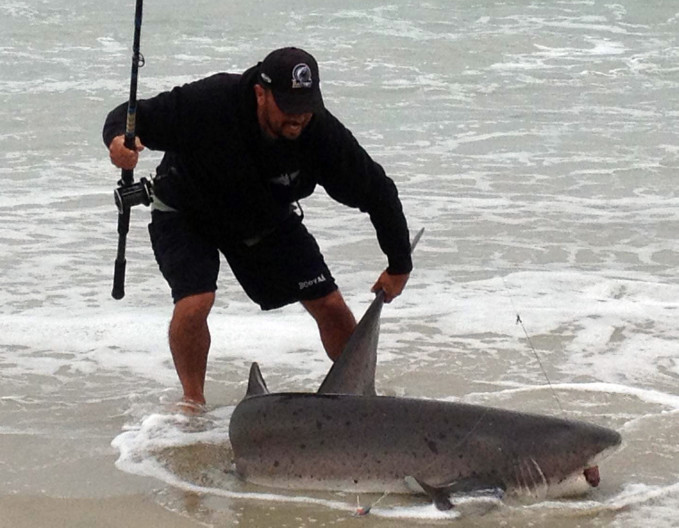
Surf fishing in Southern California for many anglers down here usually involve small bass rods and light line. There are a few who target something a little bigger and badder that swim our surf and can test your tackle as well as your back.
For years my friend Don up in LA would try to get me to go out in the surf looking for bigger surf critters. I would occasionally do so, but spending all of that time and energy getting to the beach just to find it loaded with kelp (totally unfishable) or loaded with beach goers was too much for me. Plan B was seldom an option, so I only fished this way when I knew I could actually “fish”. Don has caught many Soupfin Sharks, Leopard Sharks and Bat Rays on his long rod in the surf and constantly made
fun of my easy going and comfortable “Bay Fishing” rather than fishing the chaos of the surf.
During one of our Saturday Night Bat Fights (2009), Don calls me up to let me know that he just caught a 101” monster male Sevengill Shark! Even though it did not count for the tournament, it was by far the biggest and best thing caught in the event. This catch of his truly opened up my eyes forced my hand to get out and surf fish for big game! After all, most fishermen have an inner (friendly) competition within them to out fish their buddies at all costs.
I had a beach picked out that I wanted to try for months, but always just put it on the back burner. Finally Sasquatch nudged me to go out and give it a try one night. We armed ourselves with the long rods, steel leader and big baits. It wasn’t long before the disease spread through us as we both got a Sevengill Shark each on our first try along with some whopper Leopard Sharks. We were officially hooked at this point and have not let off the gas since.
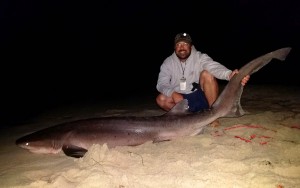 The gear is simple but the rigs have evolved over time as we started with a modified slide rig to a straight 3-way swivel rig. Here is a list of the general gear we use.
The gear is simple but the rigs have evolved over time as we started with a modified slide rig to a straight 3-way swivel rig. Here is a list of the general gear we use.
This is just what we found to work the best for us, but there is no right or wrong way if you are catching fish on your “go to” rig.
The Gear (This is just what we consider ideal, but not necessary)
• 12’ to 14’ conventional surf rod capable of throwing weights in the 6-10+ ounce range.
• High speed conventional reel capable of holding at minimum of 300 yards of 40# mono.
• Long sand spike (6’) that could accommodate the rod and possibly hold it up another 3 feet off the sand for better line clearance of the surf
• Heavy Duty Pliers
• Knife & cutting board
• Towel
• Waterproof camera
The Tackle
• 8/0 to 10/0 Hooks (XXX Octopus is our favorite, but a live bait hook will also do)
• 90# to 170# steel leader with appropriate crimps
• 3-way swivel 100# to 135#
• 150 yards of 80# braid backing / 250 yards of quality 40# mono / 20 feet of 80# shock leader
• 6 to 8 ounce Sputnik style surf sinker
• Back up rigs since it is inevitable you may lose a rig or two while fishing this manner.
The Bait
• Mackerel (Spanish or Greenies)
• Bonito
• Fresh Surf Perch
• Sardines (Not my favorite, but they do work)
• Whole Squid
*Sasquatch uses hollow braid and a nail knot to 80# shock leader to avoid the Albright Knot that I use. It keeps the big knot from going through the guides and possibly breaking out an insert as well as not ripping his thumb open on a huge cast if he doesn’t line the knot up right. Personalization is key as you need confidence in what you do. Both ways have served us well.
The next thing is to find a fishy beach depending what target you are looking for and set up. Reef, Sand, Kelp line, Sloughs, Inlets are all things you want to be looking for when deciding on where to go, but sometimes let the bait decide things for you. If there is a big grunion run going on, well there certainly will be game fish to eat the bait and BIGGER game there to eat them! It takes a lot of trial and error as each place behaves differently than another when it comes to how /when the fish bite.
We generally like the incoming tide, but have caught fish in all tide levels. We fish when we could get out, so sometimes the tide doesn’t matter as long as the surf is fishable for us to heave out a bait and let it soak for at least 10 minutes undisturbed at a time.
The general rule of thumb is to cast as far as you can. A 40-70 yard cast is usually ideal depending what bait you throw. A mackerel steak will go a hell of a lot further than 2 squid pinned on a hook or even a head for that matter. I’m not sure if it is wind resistance, density of the bait or possibly your thumb having a harder time to hold the spool on the cast and thus does not retain all of the energy of the rod loading up. If you make a short cast and there is a slough running there, then all the better. Some of these big fish really swim in skinny water (well at least for their mass).
Be prepared to spend many nights wearing the stripe as this type of fishing truly requires patience.
Now you have the cast out… and what now? Steve and I like keeping the reel in gear, but loosening up the star drag a crank or two. You want to be able to pull line off easily with your hand, but not enough for the fish to rip the rod out of the rod holder (I’ve made a small bungee rig attached to the rod holder to wrap around the rod butt as a safety strap).
Turn the clicker on and make the line taught. This will keep your line above the crashing waves and keep from bowing the line into your neighbor’s casting zone. Don’t worry about letting the fish run with the bait. Trust me, when you compare their mouths to the size bait you are using, they gobble it on the first shot and by the time you get to the rod and set the hook, it has already been on there for enough time. Each hit is different, so take what I just said with a grain of salt. Let the bite dictate how you react to setting the hook. Now it is just time to wait for the bite.
Each fish, even the same species, hits the bait differently. Some hit and run like a freight train and some seem to nibble on it just to turn out to be a monster! Once you set the hook, the fight is on and the hardest part will be landing them in the surf. Landing a fish in the bay is a cake walk compared to the pounding surf environment, not
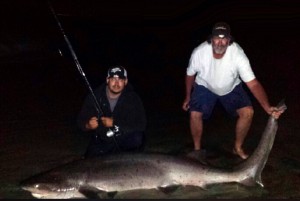 to mention your quarry is usually bigger, meaner and toothier.
to mention your quarry is usually bigger, meaner and toothier.
Make sure you take greater care in landing the fish and it is advisable to have a buddy out there helping you. A Sevengill is more of a fight for the person trying to beach the shark than the actual angler fighting it. These sharks can (and usually do) reach around in a complete circle and bite their own tail and will easily take your hand off it it gets you. Those teeth are multi-serrated and razer sharp. Don’t get complacent with your skills landing a big critter, as all it takes is that one moment of letting your guard down and BAM! It could get real ugly there fast.
Hopefully this helps you get out there and see what bigger game the surf has to offer. Be prepared to spend many nights wearing the stripe as this type of fishing truly requires patience. Look at this fishing as you are just waiting for that one bite… but that bite might be The ONE!!!!
Good luck and I may see you on the sand one day.
Tight Lines!
-Latimeria



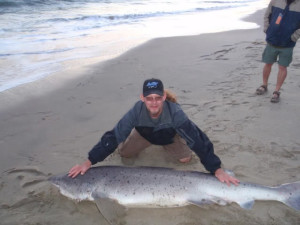



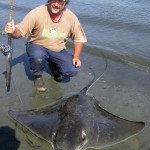
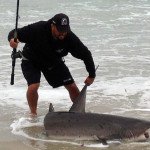
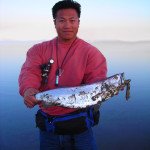
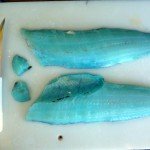
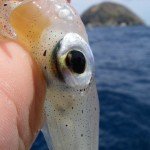
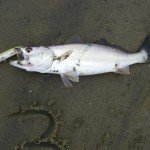
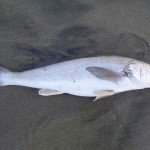

Most commented